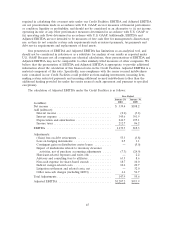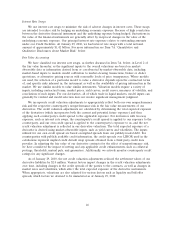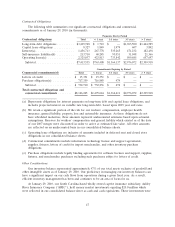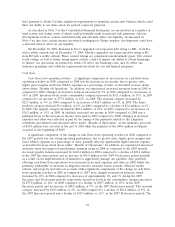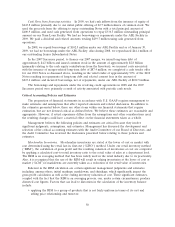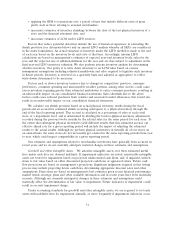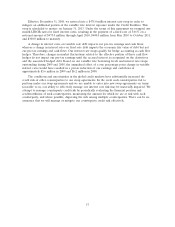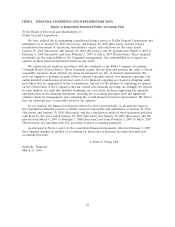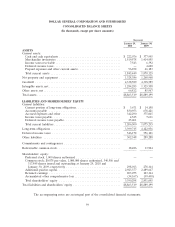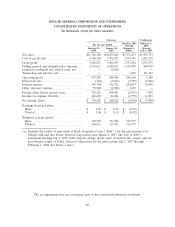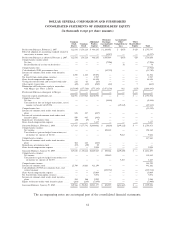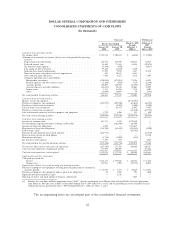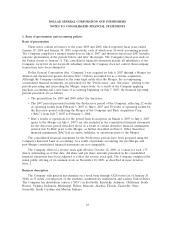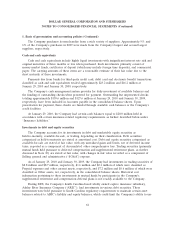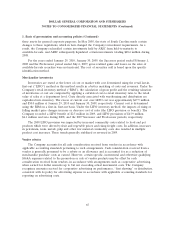Dollar General 2009 Annual Report Download - page 66
Download and view the complete annual report
Please find page 66 of the 2009 Dollar General annual report below. You can navigate through the pages in the report by either clicking on the pages listed below, or by using the keyword search tool below to find specific information within the annual report.Derivative Financial Instruments. We account for our derivative instruments in accordance with
accounting standards for derivative instruments (including certain derivative instruments embedded in
other contracts) and hedging activities, as amended and interpreted, which establish accounting and
reporting requirements for such instruments and activities. These standards require that every
derivative instrument be recorded in the balance sheet as either an asset or liability measured at its fair
value, and that changes in the derivative’s fair value be recognized currently in earnings unless specific
hedge accounting criteria are met. See ‘‘Fair Value Measurements’’ above for a discussion of derivative
valuations. Special accounting for qualifying hedges allows a derivative’s gains and losses to either offset
related results on the hedged item in the statement of operations or be accumulated in other
comprehensive income, and requires that a company formally document, designate, and assess the
effectiveness of transactions that receive hedge accounting. We use derivative instruments to manage
our exposure to changing interest rates, primarily with interest rate swaps.
In addition to making valuation estimates, we also bear the risk that certain derivative instruments
that have been designated as hedges and currently meet the strict hedge accounting requirements may
not qualify in the future as ‘‘highly effective,’’ as defined, as well as the risk that hedged transactions in
cash flow hedging relationships may no longer be considered probable to occur. Further, new
interpretations and guidance related to these instruments may be issued in the future, and we cannot
predict the possible impact that such guidance may have on our use of derivative instruments going
forward.
Accounting Standards
In June 2009 the Financial Accounting Standards Board (‘‘FASB’’) issued a new accounting
standard which established the FASB Accounting Standards Codification (‘‘ASC’’) as the source of
authoritative U.S. GAAP recognized by the FASB to be applied by nongovernmental entities. Rules and
interpretive releases of the Securities and Exchange Commission (‘‘SEC’’) under authority of federal
securities laws are also sources of authoritative GAAP for SEC registrants, including us. On
September 15, 2009, the effective date of this standard, the ASC superseded all then-existing non-SEC
accounting and reporting standards. All other nongrandfathered non-SEC accounting literature not
included in the ASC became nonauthoritative. The adoption of these standards is not expected to have
a material effect on our consolidated financial statements in the future.
In June 2009 the FASB issued a new accounting standard relating to variable interest entities. This
standard amends previous standards and requires an enterprise to perform an analysis to determine
whether the enterprise’s variable interest or interests give it a controlling financial interest in a variable
interest entity, specifies updated criteria for determining the primary beneficiary, requires ongoing
reassessments of whether an enterprise is the primary beneficiary of a variable interest entity,
eliminates the quantitative approach previously required for determining the primary beneficiary of a
variable interest entity, amends certain guidance for determining whether an entity is a variable interest
entity, requires enhanced disclosures about an enterprise’s involvement in a variable interest entity, and
includes other provisions. This standard will be effective as of the beginning of our first interim and
annual reporting periods that begin after November 15, 2009. Earlier application is prohibited. The
adoption of these standards is not expected to have a material effect on our consolidated financial
statements in the future.
During the second quarter of 2009 we adopted the ASC Subsequent Events Topic. The objective of
this topic is to establish general standards of accounting for and disclosures of events that occur after
the balance sheet date but before financial statements are issued or are available to be issued. In
particular, this topic sets forth the period after the balance sheet date during which management of a
reporting entity should evaluate events or transactions that may occur for potential recognition or
disclosure in the financial statements, the circumstances under which an entity should recognize events
or transactions occurring after the balance sheet date in its financial statements, and the disclosures
55


